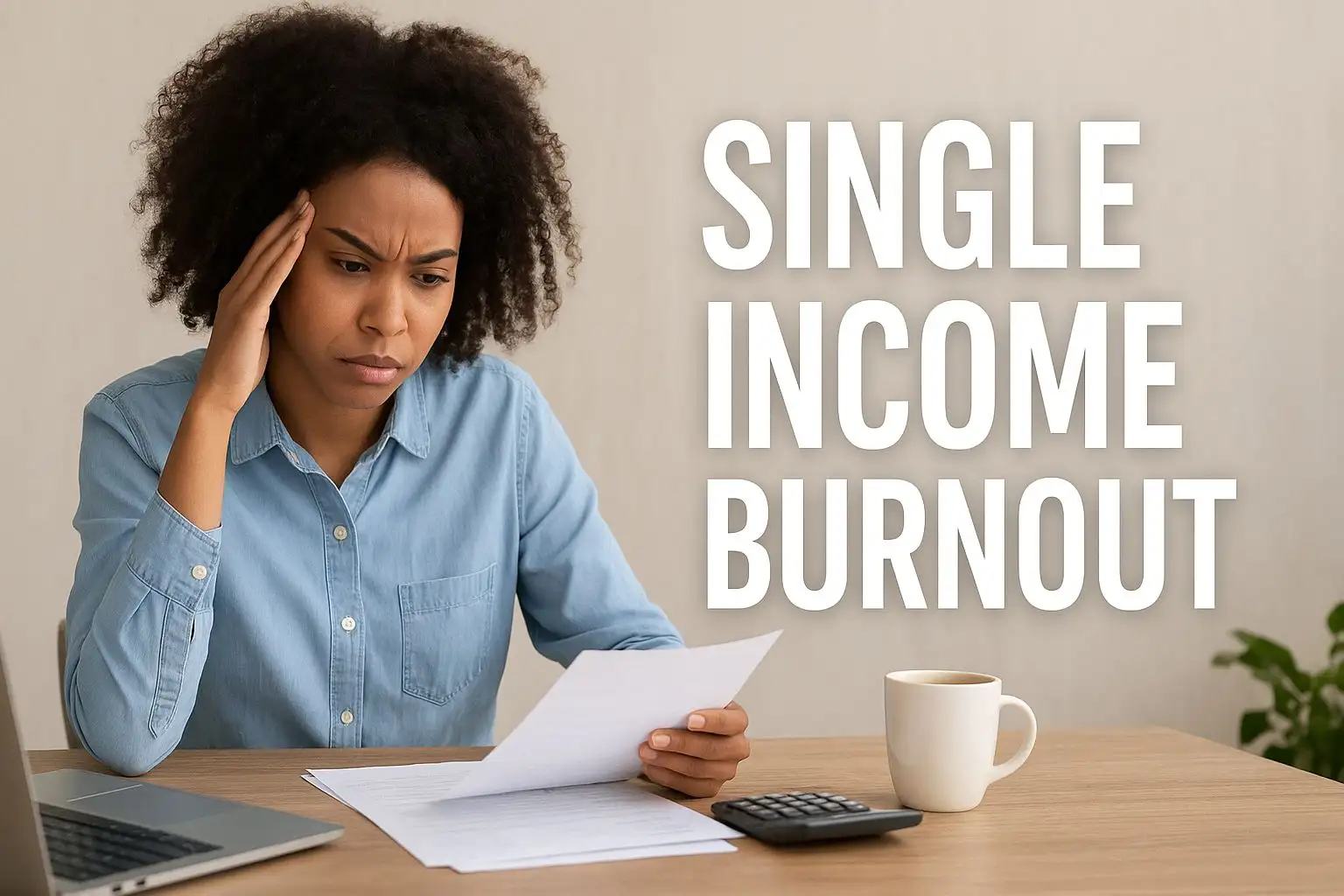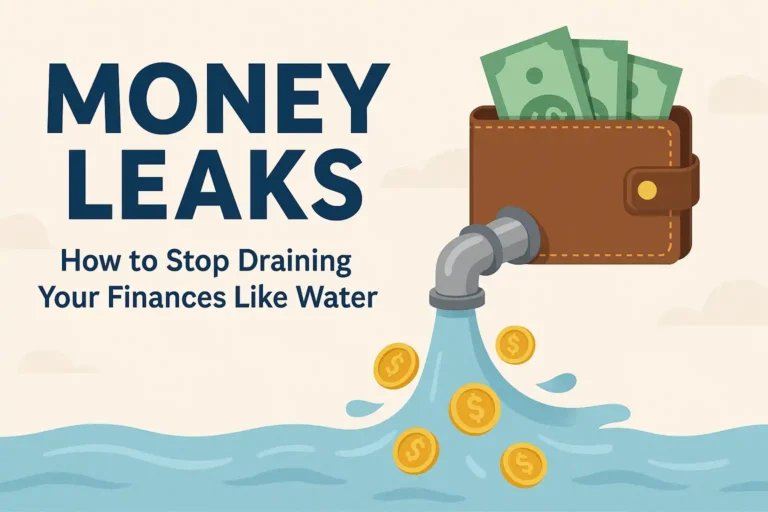Drowning in Bills?
Imagine sipping coffee with a leaky wallet – every drop of income seems to vanish before the next payday. Single income burnout is that feeling: when being the sole earner or single-income household feels overwhelming. You are not alone. In fact, roughly 30% of U.S. families live on a single paycheck. Yet many of us still wonder, “Is it stressful to be the earner in a one income household?” The answer: it can be, but it doesn’t have to end in panic. In this post, we’ll share fresh, motivational stories and easy-to-follow strategies to turn that stress into a streamlined plan. You’ll learn how to tighten your money “plumbing” and let savings flow like a full faucet. By the end, you’ll feel ready to take action – whether you are struggling with single income with a family of 5 or simply curious how to survive with one paycheck.
By reading on you will:
• Understand why one income family stress hits hard, and why financial stress is the most harmful type of stress to biological health.
• Discover practical tips from real families (yes, even SAHMs, and parents with a baby!) who survived on one income.
• Get actionable steps (with budget worksheets and self-check quizzes) that make life on one salary easier and even enjoyable.
So let’s plug those leaks and refill your cup of financial confidence!

The Pressure Cooker: Why Single Income Can Burn You Out
Story: Meet Carlos, a stay-at-home parent who supports a family of 6 on one teacher’s salary. Every month, his stress meter ticks up when the bills arrive. Carlos jokes, “It’s like juggling knives while walking a tightrope – and my safety net is only one paycheck!” Unfortunately, Carlos’s experience is not unique. Studies show single-earner families report more mental strain than dual-income peers. It is common to feel constant pressure to provide, worry about emergencies, and even guilt for missing kid activities because you are working so hard.
• Primary stressors of the sole provider: fear of losing that income, guilt about work–life balance, and no backup plan if disaster strikes. One financial coach bluntly warns that in a one-income home, the breadwinner can feel like a “de facto dictator” over the family budget – which adds emotional weight to every dollar spent.
• Health impact: Chronic money worry is seriously harmful. Research found that among all stressors (work, health, family), financial stress was “most detrimental to biological health”. Translation: hair loss, sleepless nights, headaches – you name it.
Key Lessons: Recognize these as signs of single income burnout. You are not lazy or weak; you are human. The tension is real. The good news? Awareness is step one to change.
Action Steps:
• Spot the leaks: Write down your biggest money worries (e.g., rent, car repairs, upcoming baby expenses). Name them. Awareness reduces fear.
• Share the load: If possible, loop in your partner. Even if they don’t bring in cash, let them help cut costs (couponing, freelancing, family budgeting meetings). Teamwork makes the burden lighter.
• Focus on wins: Celebrate small budget victories (paid off a bill? Saved $50 this week? Celebrate!) to replace anxiety with confidence.
Money Flow Like Water: Build Your Financial “Plumbing”
Analogy & Story: Think of your finances like water flowing through pipes. Income is the tap; bills and spending are the drains. Without a good plumbing system, all your money just disappears down the sink. Take Lisa, a mother of five. She says, “Before budgeting, I’d wonder, ‘Where did all our money go?’ It was like trying to drink from a fire hydrant with a thimble – impossible!”
By learning from water use, Lisa built a budget pipeline. She fixed leaks (canceled unused subscriptions) and installed savings buckets. The result? For the first time, she felt in control of the flow, instead of being swept away by it.
Key Lessons:
• Money in = Income, Money out = Expenses: Just like a faucet fills a bucket, each paycheck adds to your account. But if your bucket has holes (leaky spending), even a steady faucet won’t fill it.
• Channel the flow: With a plan (budget), you guide the water. Without it, your money gushes away unnoticed.
Actionable Steps:
• Create a “Money Map”: Track every dollar for a month. Use a budget app or a simple spreadsheet. Identify where the water leaks – maybe it is a $20 streaming subscription, or frequent takeout lunches.
• Build your “reservoir”: Set up an emergency fund. Just as farmers store extra water for droughts, save 3–6 months of expenses in a high-yield savings account. This rainy day fund can stop a leak from turning into a full-blown flood when life surprises you (like a job loss or baby on the way).
• Plug the leaks:
—- Renegotiate bills: Call providers to lower your insurance, utilities, or internet bills. Small reductions on big bills can save hundreds.
—- Compare and save: Use cashback credit cards responsibly or switch to a lower-cost grocery store. Every penny saved is a penny that stays in your bucket.
• Side hustles & passive streams: Add extra taps. If a little more inflow is possible, consider a side gig (online tutoring, freelancing, or a crafty side business). Even a small funnel of extra income can keep your reservoir topped off.
(Surprising stat: In dual-income countries, families with more income often have better mental health and opportunities. So any extra inflow or “1.5 income” solutions can make life easier.)
Thrive as a Team: SAHMs, Dads, and Families Unite
Relatable Story: Picture Maria, a SAHM (Stay-At-Home Mom) with a 2-year-old, who echoes the online plea: “SAHMs, how are y’all surviving on one income?” She’s not alone. Many stay-at-home parents feel isolated, thinking they must do it all. But real heroes know to ask for help and organize the household like a team.
From shared chores to mutual support groups, families can turn one income stress into a cooperative project. For example, the Johnson family (5 people on Dad’s salary) set a weekly “money meeting” over pizza (homemade for cheap!). They involve even the kids: the 7-year-old does the grocery list (“we won’t buy too many cookies!”). This team approach means no one carries the weight alone.
Key Lessons:
• Every member counts: Even if one person is the earner, the rest contribute indirectly (childcare, couponing, time). Recognize those efforts and let the non-earner have “financial wins” (like saving $10 on groceries).
• Open communication: Money shouldn’t be a taboo. Talk about bills, goals, and setbacks honestly and without blame. You’re on the same side.
Actionable Steps:
• Family Budget Meeting: Hold a casual weekly chat about money. Cover the essentials: upcoming bills, any new costs, and good news (like any unexpected bonus). Keep it upbeat – like a team huddle.
• Task Sharing: Divide responsibilities so the earner can decompress. For instance, one partner handles bill-paying (setting up autopay), the other finds weekly deals. Or swap who makes dinner and who helps with bedtime, to balance stress.
• Support Networks: Join local or online groups for one-income families. Many blogs, forums, or Facebook groups (like r/PersonalFinance or r/StayAtHomeMom) share tips and moral support. You might pick up a recipe swap or a job opportunity!
• Self-care: The most important step is you. Make time (even 10 minutes) for a quick walk, coffee with a friend, or journaling. Burnout is worse for everyone; a calm, rested parent makes better decisions.
(Fun fact: In families with younger children, stress is surprisingly lower in dual-earner households, according to a European study. That’s not to shame SAHMs/DHs (Stay-at-Home Mothers and Dear/Darling Husband) – it just means extra effort or outside help (like family childcare) can relieve that gap.)

Silver Linings & Storm Clouds: Pros and Cons of One Income
Personal Note: Every coin has two sides, and a single-income family does, too. Frankly asking “What are the advantages and disadvantages of having only one income earner in the family?” helps set realistic expectations.
Advantages:
• More Time, Less Daycare: One parent (or partner) can focus on home, kids, or personal projects full-time. This can lower childcare costs and mean more family dinners or bedtime stories.
• Unified Goals: With one salary, you literally share one budget. Couples who openly budget together often report stronger teamwork (they’re literally working toward the same number on paper).
• Simplicity: One bank account can simplify tracking. No more arguing over who spent what!
• Tax Benefits (sometimes): Depending on your region, being a single-income family might move you into a lower tax bracket or qualify you for certain credits. It’s worth researching.
Disadvantages:
• Financial Pressure: You (or your household) cover all expenses on one check. A missed paycheck or unexpected medical bill hits harder.
• Slower Wealth-Building: Dual-income families can often save and invest faster. With one income, things like retirement savings or college funds may grow more slowly.
• Risk of Burnout: We’ve covered this – pressure is real. The sole earner may feel isolated responsibility, and the non-earner can feel career stifled.
• Social Stigma: Some folks get unsolicited opinions (like “Wow, are not you struggling?”). It helps to ignore critics and remember you made a choice that works for your values.
Key Takeaway: No setup is perfect. The goal is maximizing the advantages (more time, aligned purpose) and minimizing the pitfalls (by budgeting, saving, and protecting yourself).
Success and Stress: Does Money Ease the Burn?
You might wonder, “Do sole income earner stressors decrease with success?” In other words, if you suddenly get that big raise or inheritance, will the burnout vanish? Partially, yes – more income usually eases basic money worries. A Gallup poll found that stress tends to fall as income rises up to a point. Hitting around $60k–$90k per year, stress tends to bottom out; beyond that, those extra dollars matter less for day-to-day anxiety.
However, higher income can bring new pressures: keeping up expensive lifestyles, longer work hours, or fear of losing it all (the classic “affluenza” trap). So even if your sole income surges, do not ditch these tips!
Actionable Steps:
• Reassess and Adjust: If your income grows, decide first to raise your savings rate before inflating your lifestyle. Treat the extra as semi-sacred: add to the emergency fund or pay down debt.
• Debt Avalanche: Use any bonus to crush high-interest debts. Each debt paid cuts future stress — it’s like widening your budget’s drain so money can flow to savings instead of interest.
• Continuing the Plan: Keep talking money with your family, even if things look rosier. Transparency when success hits prevents future misunderstandings and keeps stress low.##
Interactive Quiz: Are You Heading for Burnout?
(Check how “full” your stress tank is with this quick self-assessment. Count yes answers to see your burnout level.)
• I often lie awake worrying about next month’s bills.
• I have little to no emergency savings.
• Arguments at home sometimes start over money.
• I rarely or never take a break from budgeting concerns.
• I feel guilty even thinking about leaving my job or changing careers.
• My health (sleep, appetite, mood) has suffered due to money worries.
Scoring: If you checked 3 or more, you’re approaching burnout territory. Time to act! Even 1–2 checks means tension is creeping in. Use the strategies above – tighten your budget, open that savings account, and talk to your loved ones about sharing the load.
(Bonus: Turn this into a printable checklist by jotting your own “money leaks” or stress triggers in a notebook. Seeing them listed can be the first step to fixing them!)

📌 FAQs: Living Well on One Income Without Burnout
- What are the primary stressors with being the sole income earner in a family?
The biggest stressor of being the sole provider is the constant feeling that one income family stress never goes away. Bills, debt, and daily expenses all fall on one paycheck. This creates a “what if” anxiety—what if I lose my job? What if the car breaks down?
Another major stressor is emotional burnout. A sole breadwinner often feels pressure to work longer hours, leaving less time for family. Meanwhile, the non-earning partner may feel undervalued, even though they contribute through childcare and home management. Over time, this imbalance can create arguments and resentment.
Actionable Tip: Reduce stress by setting up an emergency fund and ensuring your family has clear communication about spending priorities. Even talking openly once a week about money can cut anxiety in half. Remember, Single Income Burnout often comes more from silence and fear than from actual financial shortage.
- How do I get my family stress free in sole income?
Stress-free living on one paycheck starts with planning, teamwork, and mindset. Money fights usually come from unclear priorities. Sit down with your partner and write out your must-haves (housing, groceries, healthcare) and nice-to-haves (vacations, gadgets, eating out). Once the essentials are covered, you’ll feel lighter.
To keep Single Income Burnout away, involve the whole family. Kids can learn frugal habits like helping with meal prep, turning off lights, or finding cheaper alternatives. The partner at home can contribute through side hustles or cost-cutting strategies. Even saving $100 a month in expenses creates a ripple effect.
Actionable Tip: Automate savings and bills to avoid missed payments. A stress-free system is one where money flows like water in well-placed channels—controlled, steady, and predictable.
- What is the average salary of single-income family households?
The average salary of single-income family households varies widely depending on location, cost of living, and family size. In the U.S., many single-income families earn between $50,000–$75,000 annually. But what matters most isn’t the number—it’s how well you manage it.
For instance, a family of 5 living on one income of $60,000 in a small town may feel comfortable, while a family of 5 in a major city may struggle on $90,000. The truth: Single Income Burnout doesn’t always depend on salary; it depends on expenses, debt, and lifestyle expectations.
Actionable Tip: Focus on your savings rate (percentage of income saved) instead of comparing salaries. Even 10% saved from a modest income can build long-term wealth.
- How to live on one income with 1 baby?
Raising a baby is joyful but expensive. Parents often ask: “How to live on one income with 1 baby?” The key is to simplify and prioritize. Baby items like cribs, clothes, and toys can add up fast, but remember: babies don’t need luxury, they need love, safety, and care.
• Borrow or buy second-hand baby gear.
• Focus on health insurance and emergency savings—medical costs can spike unexpectedly.
• Rework your budget to include diapers, formula, and childcare if needed.
Pro Tip: Consider setting up a “baby sinking fund” before birth. Just $100 a month during pregnancy builds a $1,000+ cushion for the first year. This reduces one income family stress and helps parents stay financially calm instead of panicked.
- We’re struggling with single income with a family of 5. What should we do?
If you’re struggling with single income with a family of 5, the most important step is budget clarity. Write down your top 10 monthly expenses and rank them. Often, families discover that subscriptions, takeout, or car costs eat more than housing or food.
Once you see the leaks, you can cut or swap. For example:
• Switch from eating out twice a week to once a month (save $200+).
• Drive one family car instead of two (insurance + gas savings).
• Meal prep with bulk groceries for big families.
The reality: families of 5 can thrive on one income if they treat budgeting like a team sport. Every family member contributes—whether it is cutting waste, cooking meals, or finding free entertainment. The real battle isn’t income, it’s mindset and teamwork.
- Is it even possible if we are struggling with single income with a family of 6?
Yes, it is possible—but it requires a higher level of discipline. Struggling with single income with a family of 6 feels harder because every cost multiplies (more kids = more food, clothing, and future college expenses). But remember: bigger families often learn teamwork faster.
Action Plan for Families of 6:
• Housing: Keep it modest. Mortgage/rent should stay under 30% of income.
• Food: Use bulk shopping (Costco, Aldi) and family meal plans. Cook once, eat twice.
• Clothing: Rotate hand-me-downs, accept donations, and shop sales.
• Income protection: Get term life insurance for the breadwinner to shield the family.
It is demanding, but many families of 6 prove it can be done with focus. Avoid comparing yourself to dual-income neighbors. Instead, set your family’s unique goals and chase them together.
- Do sole income earner stressors decrease with success?
Yes—but only partly. A higher salary can lower Single Income Burnout, but it won’t erase it. Research shows stress decreases as income rises to a comfortable level, but after that, extra money doesn’t necessarily add happiness.
Why? Because success brings new pressures—longer hours, lifestyle inflation, or fear of losing your status. In fact, some high earners report even more anxiety because their spending grows faster than their income.
Actionable Tip: If your income rises, freeze your lifestyle for at least six months. Direct extra money to debt repayment, investments, or building your emergency fund. That way, your one income family stress decreases instead of just shifting into new forms.
- What are the advantages and disadvantages of having only one income earner in the family?
Advantages:
• One parent can focus on kids or home life.
• Lower daycare and commuting costs.
• Clearer budgeting with just one paycheck.
• Stronger teamwork if communication is healthy.
Disadvantages:
• Vulnerability if the earner loses their job.
• Slower savings and retirement growth.
• Risk of Single Income Burnout if balance isn’t maintained.
• The non-earning partner may feel undervalued or stuck.
The solution is to actively protect against the downsides: create safety nets, respect both partners’ contributions, and always have a backup plan.

Conclusion: Reclaim Control and Flow Forward
Single Income Burnout does not have to become your reality. By treating money like water—channeling it wisely, plugging leaks, and celebrating every drop of progress—you transform stress into stability. We have seen how families of 5 or even 6 can thrive: they communicate, budget creatively, and build emergency funds to weather any storm. Remember, you are not a dictator of doom; you are a problem-solver with a plan.
Make no mistake: overcoming one income family stress takes work, but the wins are huge. Your family gains security, your health thanks you, and your confidence skyrockets. The journey from “living paycheck to paycheck” to feeling empowered is made step by step, budget by budget. You can do this. Start today by taking one action from this post – whether it is setting up a new savings account, having a candid talk with your partner, or simply Googling “average salary of single-income family” to get perspective. Each step is a wave in your direction of freedom.
Every sentence you tackle, every dollar you save, pushes you closer to calm. You have got this.
Call to Action
• Share Your Story: Comment below with your biggest single income challenge or win. Your experience might just spark an idea for someone else!
• Spread the Word: If you found value here, share this post on social media. Help other families convert burnout into boost!
• Stay Connected: Subscribe to TheFitFinance newsletter for more tips, real-life stories, and free budgeting tools delivered weekly.
• Free Resources: Want to start applying these steps right away? Comment below or email me for your free ‘One-Income Budget Worksheet‘!
Finally, keep the momentum going – check out our previous post on embracing frugality and smart spending strategies for even more inspiration. (Trust us, it’s the perfect companion to make your financial future flow smoothly!)







